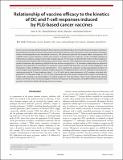| dc.contributor.author | Ali, Omar Abdel-Rahman | |
| dc.contributor.author | Doherty, Edward | |
| dc.contributor.author | Mooney, David J. | |
| dc.contributor.author | Emerich, Dwaine | |
| dc.date.accessioned | 2014-02-25T12:50:54Z | |
| dc.date.issued | 2011 | |
| dc.identifier.citation | Ali, Omar A., Edward Doherty, David J. Mooney, and Dwaine Emerich. 2011. Relationship of vaccine efficacy to the kinetics of dc and t-cell responses induced by plg-based cancer vaccines. Biomatter 1(1): 66-75. | en_US |
| dc.identifier.issn | 2159-2527 | en_US |
| dc.identifier.uri | http://nrs.harvard.edu/urn-3:HUL.InstRepos:11743703 | |
| dc.description.abstract | Cancer vaccines are typically formulated for bolus injection and often produce short-lived immunostimulation resulting in poor temporal control over immune cell activation and weak oncolytic activity. One means of overcoming these limitations utilizes immunologically active biomaterial constructs. We previously reported that antigen-laden, macroporous PLG scaffolds induce potent dendritic cell (DC) and cytotoxic T-lymphocyte (CTL) responses via the controlled signaling of inflammatory cytokines, antigen and toll-like receptor agonists. In this study, we describe the kinetics of these responses and illustrate their fundamental relationship to potent tumor rejection when implanted subcutaneously in a mouse B16 model of melanoma. By explanting scaffolds from mice at times ranging from 1–7 d, a seamless relationship was observed between the production of controlled CTL responses, tumor growth and long-term survival in both prophylactic and therapeutic models. Scaffolds must be implanted for > 7 d to augment CTL responses via the prolonged presentation of tumor antigen, and the benefits included a notable regression of established tumors. Host DC infiltration into the porous material persisted for 12 days (peaking at day 5 ~1.4 x 106 cells), and a sharp attenuation in DC numbers coincided with peak CD8+ CTL infiltration at day 12 (~8 x 105 cells). Importantly, these PLG systems enhanced DC numbers in the draining lymph node, resulting in increased CD8(+) CTL subsets at days 10–16 of vaccination. These results indicate that material systems can finely control innate and adaptive immune cell responses to kill typically untreatable melanoma tumors and provide critical kinetic data for the design of vaccine carriers. | en_US |
| dc.description.sponsorship | Engineering and Applied Sciences | en_US |
| dc.language.iso | en_US | en_US |
| dc.publisher | Landes Bioscience | en_US |
| dc.relation.isversionof | doi:10.4161/biom.1.1.16277 | en_US |
| dc.relation.hasversion | http://www.ncbi.nlm.nih.gov/pmc/articles/PMC3548245/pdf/ | en_US |
| dash.license | LAA | |
| dc.subject | biomaterials | en_US |
| dc.subject | cancer | en_US |
| dc.subject | dendritic cells | en_US |
| dc.subject | drug delivery | en_US |
| dc.subject | host response | en_US |
| dc.subject | immunity | en_US |
| dc.subject | immunotherapy | en_US |
| dc.subject | vaccine | en_US |
| dc.title | Relationship of vaccine efficacy to the kinetics of DC and T-cell responses induced by PLG-based cancer vaccines | en_US |
| dc.type | Journal Article | en_US |
| dc.description.version | Version of Record | en_US |
| dc.relation.journal | Biomatter | en_US |
| dash.depositing.author | Mooney, David J. | |
| dc.date.available | 2014-02-25T12:50:54Z | |
| dc.identifier.doi | 10.4161/biom.1.1.16277 | * |
| dash.contributor.affiliated | Ali, Omar Abdel-Rahman | |
| dash.contributor.affiliated | Mooney, David | |


